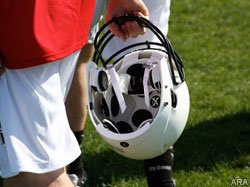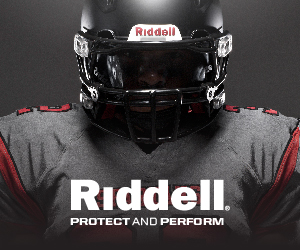Guidelines for properly fitting football helmets have been issued. The guidelines, believed to be the first protocol of their kind, were presented as part of a research paper presented to the American Orthopaedic Society for Sports Medicine meeting in San Francisco in February 2012 which found that making sure that football helmets fit properly, and that those with air bladder linings are properly inflated, may be two of the simplest but most effective ways to minimize the risk of concussion and catastrophic brain injury in the sport.*
"As we look at preventing concussions and minimizing risk, it is important to realize that it is the responsibility of the athletic director and head football coach to have policies that: Insure that each player has a properly-fitted helmet and that a responsible adult supervises and oversees proper helmet air bladder inflation on a weekly basis," said Joseph Torg, MD, lead author of the paper and a professor at Temple University in Philadelphia, who developed the guidelines with the assistance of Paul Kelly, Athletic Equipment Supervisor at Temple University and a certified member of the Athletic Equipment Manager's Association.
Buying different style helmets
The guidelines recognize, as a preliminary matter, that:
- While there is no "concussion proof" helmet, concussions or the severity of concussion can be minimized with a properly fitted helmet combined with proper playing technique;
- As heads come in various shapes and sizes, when it comes time for a football program to purchase helmets, it should buy more than one style, as carrying at least two styles will allow the program to fit a broad range of heads; and
- The pamphlet that accompanies all newly purchased helmets needs to be kept on file, updated and old versions replaced.
Helmet fitting is step-by-step process
Step1. Prepare Helmets
Before beginning any helmet fitting session, all the helmets should be properly prepared.
- Inspect each helmet, inside and out making sure it is clean and there are no defects.
- Be sure any used helmet has been properly reconditioned.
- Be certain that the NOCSAE stamp and helmet warning label is clearly legible on the outside of the helmet.
Step 2. Obtain Athlete Information
Ask if athlete has ever had any prior concussions or a broken nose. Find
out what kind of helmet was worn before and if there were any issues.
Ask how did it fit and how it felt? Check for any physical abnormalities on athlete's head.

Step 3. Measure Head
Using a cloth tape measure, begin at the side of the head and wrap around about 1 inch above the eyebrow and around the occipital lobe to obtain head circumference to determine
Helmet size.
- Medium will range around 20-22.5 inches
- Large will range around 21.5-23.25 inches
- XL will range around 23-25.5 inches
Step 4. Select Helmet and Fit
This is based on product knowledge and information from the last 2 steps. There will be variance.
- Athlete may try on 2 or 3 helmets and should select the one most comfortable.
- To fit helmet selected, follow manufacturers fitting instructions.
- Inflation should raise the frontal rim of helmet about one inch above eyebrow and snug around circumference of the head.
- Jaw pads should be touching the jaw and not the ears.
- The rear padding should be infirm but with comfortable contact with the head.
Step 5. Chinstrap
The chinstrap simply keeps the helmet on the head while playing. The
chinstrap is not a means to adjust the fit of the helmet. With the cup
centered on the chin, the front or high should first be adjusted and
buckled followed by the rear or low hook straps.
There should be equal tension on all the straps.
Step 6. Check Fit
- Crown pressure: Pull helmet straight down on athlete's head. You are looking for the pressure to be evenly distributed on the top of the head and the helmet should not come down on the nose.
- Lateral grip: Place your hands on each side of the helmet and ask the athlete to hold the head still. Gently force the helmet from side to side. What you are looking for here is the helmet padding to grip the head and not slide across the face. Facial skin should bunch up.
- Vertical grip: Again, place your hands on each side of the helmet and ask the athlete to hold the head still. Gently roll the helmet backward and forward. The skin on the forehead should move with the helmet and with enough force it will eventually slip a little ,but it should catch on the eyebrow without coming down on the nose.
Step 7. Maintenance
- Helmets, especially air bladder helmets, will change throughout the season.
- Helmets should be examined weekly to insure they remain properly fitted in good condition.
- Recheck the air-bladder suspension and helmet fit following the above guidelines.
- Fill the bladder only while the helmet is in place on the athlete's head. Facemasks may be bent with contact. Replace as needed.
- Check helmet shell for cracks and helmet hardware for rust. Replace screws as needed to insure the facemask can be removed easily in an emergency.
Final steps
When you have completed the fitting, ask whether the athlete is comfortable with the helmet, and let the athlete know that you are pleased with the fit. Record all pertinent information about the athlete's helmet and be sure it is specifically distinguished for the respective athlete.
Be sure to explain to the athlete what you are doing through each step and why. This serves 2 purposes. The athlete's trust in you is reinforced and will be confident not worrying about getting hurt when playing. More importantly it educates the athlete to quicker troubleshoot any problems that may occur with the helmet.
For more information, please visit www.AEMA1.com.
Need an expert to speak about football helmet safety? Ask Brooke de Lench the Producer/Director of THE SMARTEST TEAM: Making High School Football Safer (PBS 2013) - delench@MomsTEAM.com
*Important note: Dr. Torg's research paper, while presented to a respected sports medicine organization, was never published in a peer-reviewed journal. While there are numerous reasons why a research paper is never published, it is possible that the paper could not pass the rigorous scientific scrutiny such journals demand before publication, and thus his findings should be viewed with caution, especially since MomsTEAM is not aware of anything in the medical literature replicating his findings.
1. Torg J, Boden B, Hirsch H, Fowler J, Gaughan J, Comstock RD, Tierney R, Kelly P. Athletic Induced mTBI and Catastrophic Intracranial Injuries: Determining Helmet Efficacy and Predisposing Injury Profiles. Presentation Paper AOSSM 2012.
Posted February 12, 2012; revised November 12, 2014









